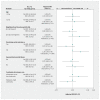Rapid repeat pregnancy among women with intellectual and developmental disabilities: a population-based cohort study
- PMID: 30104188
- PMCID: PMC6089941
- DOI: 10.1503/cmaj.170932
Rapid repeat pregnancy among women with intellectual and developmental disabilities: a population-based cohort study
Abstract
Background: Rapid repeat pregnancy within 12 months of a live birth is associated with adverse perinatal outcomes. We evaluated the risk for rapid repeat pregnancy among women with intellectual and developmental disabilities, with whom sharing of information about pregnancy planning and contraception may be inadequate.
Methods: We accessed population-based health administrative data for all women with an index live birth in Ontario, Canada, for the period 2002-2013. We used modified Poisson regression to compare relative risks (RRs) for a rapid repeat pregnancy within 12 months of the index live birth in women with and without intellectual and developmental disabilities, first adjusting for demographic factors and then additionally adjusting for social, health and health care disparities.
Results: We compared 2855 women with intellectual and developmental disabilities and 923 367 women without such disabilities. At the index live birth, women with intellectual and developmental disabilities were more likely to be younger than 25 years of age (46.8% v. 18.2%) and to be disadvantaged on each measure of social, health and health care disparities. These women had a higher rate of rapid repeat pregnancy than those without such disabilities (7.6% v. 3.9%; adjusted RR 1.34, 95% confidence interval [CI] 1.18-1.54, after controlling for demographic factors). This risk was attenuated upon further adjustment for social, health and health care disparities (adjusted RR 1.00, 95% CI 0.87-1.14).
Interpretation: Rapid repeat pregnancy, which was more common among women with intellectual and developmental disabilities, may be explained by social, health and health care disparities. To optimize reproductive health, multifactorial approaches to address the marginalization experienced by this population are likely needed.
© 2018 Joule Inc. or its licensors.
Conflict of interest statement
Competing interests: None declared.
Figures


Similar articles
-
Maternal and offspring outcomes in women with intellectual and developmental disabilities: a population-based cohort study.BJOG. 2017 Apr;124(5):757-765. doi: 10.1111/1471-0528.14120. Epub 2016 May 24. BJOG. 2017. PMID: 27222439
-
Labour and delivery interventions in women with intellectual and developmental disabilities: a population-based cohort study.J Epidemiol Community Health. 2016 Mar;70(3):238-44. doi: 10.1136/jech-2015-206426. Epub 2015 Oct 8. J Epidemiol Community Health. 2016. PMID: 26449738
-
Postpartum Acute Care Utilization Among Women with Intellectual and Developmental Disabilities.J Womens Health (Larchmt). 2017 Apr;26(4):329-337. doi: 10.1089/jwh.2016.5979. Epub 2017 Jan 24. J Womens Health (Larchmt). 2017. PMID: 28118072
-
Pregnancy in women with physical and intellectual disability: psychiatric implications.Riv Psichiatr. 2020 Nov-Dec;55(6):331-336. doi: 10.1708/3503.34890. Riv Psichiatr. 2020. PMID: 33349725 Review.
-
Maternal disability and risk for pregnancy, delivery, and postpartum complications: a systematic review and meta-analysis.Am J Obstet Gynecol. 2020 Jan;222(1):27.e1-27.e32. doi: 10.1016/j.ajog.2019.07.015. Epub 2019 Jul 12. Am J Obstet Gynecol. 2020. PMID: 31306650 Free PMC article.
Cited by
-
Postpartum Health Care Among Women With Intellectual and Developmental Disabilities.Am J Prev Med. 2020 Sep;59(3):437-444. doi: 10.1016/j.amepre.2020.03.011. Epub 2020 Jun 27. Am J Prev Med. 2020. PMID: 32605865 Free PMC article.
-
Contraceptive Practices and Reproductive Health Considerations for Adolescent and Adult Women with Intellectual and Developmental Disabilities: A Review of the Literature.Sex Disabil. 2019 Oct;37(4):541-557. doi: 10.1007/s11195-019-09600-8. Sex Disabil. 2019. PMID: 33005065 Free PMC article.
-
Challenges in Providing Reproductive and Gynecologic Care to Women With Intellectual Disabilities: A Review of Existing Literature.J Family Reprod Health. 2022 Mar;16(1):9-15. doi: 10.18502/jfrh.v16i1.8589. J Family Reprod Health. 2022. PMID: 35903769 Free PMC article. Review.
-
Reproductive and pregnancy health care for women with intellectual and developmental disabilities: A scoping review.J Appl Res Intellect Disabil. 2022 May;35(3):655-674. doi: 10.1111/jar.12977. Epub 2022 Jan 22. J Appl Res Intellect Disabil. 2022. PMID: 35064736 Free PMC article.
-
A Socio-Ecological Approach to Understanding the Perinatal Care Experiences of People with Intellectual and/or Developmental Disabilities in Ontario, Canada.Womens Health Issues. 2021 Nov-Dec;31(6):550-559. doi: 10.1016/j.whi.2021.08.002. Epub 2021 Sep 21. Womens Health Issues. 2021. PMID: 34556400 Free PMC article.
References
-
- Conde-Agudelo A, Rosas-Bermúdez A, Kafury-Goeta AC. Birth spacing and risk of adverse perinatal outcomes: a meta-analysis. JAMA 2006;295:1809–23. - PubMed
-
- Boardman LA, Allsworth J, Phipps MG, et al. Risk factors for unintended versus intended rapid repeat pregnancies among adolescents. J Adolesc Health 2006;39:597.e1–8. - PubMed
-
- Appareddy S, Pryor J, Bailey B. Inter-pregnancy interval and adverse outcomes: evidence for an additional risk in health disparate populations. J Matern Fetal Neonatal Med 2017;30:2640–4. - PubMed
Publication types
MeSH terms
LinkOut - more resources
Full Text Sources
Other Literature Sources
Medical
